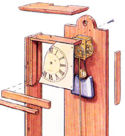Building a Shaker Wall Clock
Choose your movement first, then build the clock around it
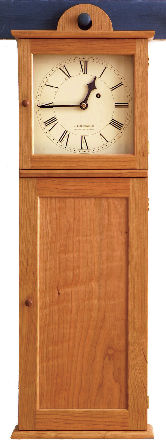 | |
I have no qualms with historical accuracy, except when it comes to techniques that may have worked in the past but are not suitable today. Wood movement is one of those areas. The Shakers did not have to deal with forced hot-air heat. We do. Shaker clock makers built their cases to fit their mechanisms. We must build our cases to fit mechanisms that are commercially available today. To me, that seems perfectly aligned with Shaker ideals.
For starters, the original clock was constructed predominantly of white pine. I chose cherry for its color, hardness and grain. Because cherry moves more than white pine does, I had to make a few dimensional adjustments to allow for wood movement of the back panel. Second, I decided to use a top-of-the-line mechanical movement, which required a small amount of additional interior space. Consequently, my overall case is a little deeper, and the back is a bit thinner. So much for historical accuracy.
|
|
||||||||
Make the case to fit the clock parts
I never start construction on a clock until I have the movement, dial and hands (see A movement for every price range). Having these at the ready makes it much easier to fit the dial and allow proper clearance between the shaft, the hands and the glass, as well as the clock movement and the case back. I hate surprises.
Once you have the clock parts, you can cut the sides of the case to size. Then cut 3/8-in. by 1/2-in. rabbets to accept the back. The front of each side receives a stopped rabbet to accept the face. You could simply make the clock an inch wider and avoid cutting rabbets in the front, but -- for reasons more aesthetic than historical -- I prefer to keep proportions closer to the original.
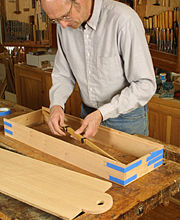 | |
|
The false top and false bottom
are simply butt-joined and glued to the sides. The actual top
and bottom will reinforce this joint. Before the glue sets,
check to make sure the case is level and square. | |
On the original, the top and bottom were merely nailed onto the sides. I use long, thin screws and plugs. Another alternative is dowels. I once had a student who attempted to use sliding dovetails, only to discover that they lasted from 12 until noon. With only 9/16 in. of overhang on the sides and part of that cut away by the rabbet, the remaining end grain is extremely fragile.
I prefer to use a false bottom and top, which not only make glue-up easier but also act as a doorstop in front and create rabbets to house the back. Glue the false top and bottom to the sides using butt joints. Once the glue dries, center the actual top and bottom on the case and screw them into the sides.
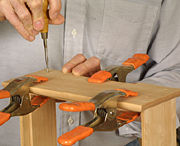 |
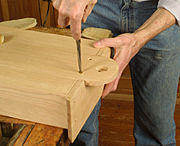 | |
|
The top is screwed straight into
the sides, then plugged and trimmed flush. |
The back is screwed only near
the center. The edges are then nailed into place, allowing for
seasonal movement. |
The clock back simply butts up against the false top and bottom and is screwed into place from behind. However, this is where wood movement comes into play. The back is about 9-1/2 in. wide, which means that a piece of flatsawn cherry will move about 5/32 in. (from 6% moisture content in winter to 13% moisture content in summer). If you can locate or glue up a quartersawn back, the amount of movement is cut in half, to 5/64 in. So, if you're building in the summer, when the back has reached a moisture content of near 12% or 13%, the back can be fitted tightly. In the winter, when the moisture content of the back is closer to 6%, a gap of just under 3/64 in. is required on each side. Also, leave a small gap where the half-round hanger protrudes through the top.
Another change I make is to increase the size of the hanger hole, from 1/2 in. to 1-1/8 in., to allow the clock to be hung on a Shaker peg. The back is merely nailed into place, with a dab of glue in the center to ensure that wood movement is equal in both directions.
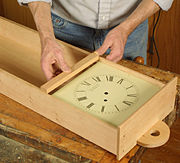 |
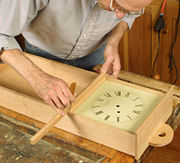 | |
|
The horizontal divider is sized
to act as a doorstop for both doors. It is set into the stopped
rabbet that holds the clock face. | ||
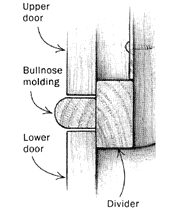 | |
|
Bullnose molding separates top
and bottom doors. Shape the profile using a roundover bit, then
cut it to fit flush with the sides. | |
At this point it pays to plan ahead. Measure the depth of the movement to check that you have proper clearance for both the shaft and the glass of the door. Mechanical movements are either attached directly to the back -- as I've done -- or sit on a shelf. Quartz movements, being much shallower, are usually attached to the dial. If you use a spacer, the movement can also be attached to the case back. Planning ahead allows you to position the dial so that the hand shaft is close to the glass but does not touch it. Once you've established the location of the dial, glue two vertical filler strips to the inside of the case. Thick metal dials like the one I used can be screwed to these strips directly, while thin metal or paper dials should be adhered to 1/4-in.-thick plywood backings.
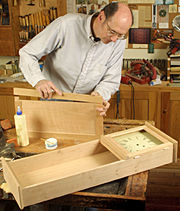 | |
|
Before applying glue, carefully
dry-fit the doors and see that they fit the case. | |
The doors are relatively straightforward, mortised and tenoned at each corner (see Door-joinery details). Cut haunched mortise-and-tenon joints on center, and make sure to offset the glass and panel grooves to allow room for the thumbnail profile along the fronts. The frames are 1/2 in. thick, and the bottom panel is only 3/16 in. thick. The 3/16-in. quarter-round moldings are added after the panel is in place. On the top door, add the quarter-round moldings to hold the glass on the outside, and add 3/16-in. glass supports, nailed from the inside, to hold the back of the glass.
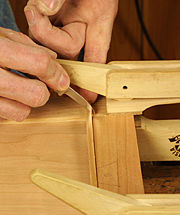 |
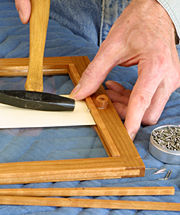 | |
|
The quarter-round molding is
shaped on the router, then mitered to fit the door. Becksvoort
simply glues the molding to the rails and the stiles. |
After the glass is set
into the rabbet, small glass supports are nailed into place. |
As far as a finish goes, I am partial to Tried & True Varnish Oil. It leaves a silky, penetrating finish that I prefer. More accurate for this clock would be a shellac finish, which was used on the original.
When hanging the clock from a peg board, carve a 1/2-in. flat spot at the top of the peg where it meets the hanger, leaving a slight ridge, to keep the clock from sliding forward on the peg. If the peg board is 3/4 in. thick, use a 3/4-in. spacer behind and near the bottom of the clock. A toggle bolt or similar anchor will attach the spacer to drywall or plaster if there is no stud nearby. Once the clock is perfectly plumb and running smoothly, drill a hole through the back into the spacer and anchor the clock with a screw. This keeps it from shifting during winding or an accidental bump.
